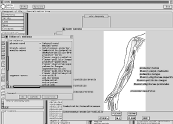An Assistant for Planning Neuro-Muscular Tests
by Danielle Ziébelin and Annick Vila
MYOSYS is an expert system, which has been developed to help clinicians identify neuro-muscular pathologies through the use of electromyographic (EMG) techniques. It is based on the experience accumulated within the European ESTEEM project. In MYOSYS, the following well-defined steps occur: generation of diagnosis hypotheses based on symptoms, elaboration of examination procedures suited to the patient, interpretation of examination results, conclusion formulation, and validation or reviewing of the current hypothesis. The system is specifically useful for advising the practitioner on both the choice and sequencing of suitable tests, which can avoid unpleasantness for the patient.
The project has been motivated by the complexity of EMG examination, especially for novice practitioners who wish to become experts. They propose either too long, costly, and painful examination for the patient, or an inadequate examination procedure. Meanwhile, they do not consider associated pathologies, and they neglect to carry out the accurate examination to confirm the diagnosis.
MYOSYS takes into account the first steps of EMG examination: from the symptoms evocation to the tests procedure elaboration. The reasoning process is implemented upon a generic problem solving environment, which relies on the representation of two types of knowledge:
- entities model the domain concepts, such as symptoms, procedures, anatomy, pathologies or tests and constitute the knowledge base. Any piece of knowledge is represented by an object (see figure 1).
- tasks describe an examination step. This description is composed of input/output data and also, of an adequate problem-solving strategy. The problem-solving strategy is based on the recursive decomposition of each complex task into more elementary subtasks (see figure 2). Tasks being themselves represented by objects, this results in a hierarchical organisation of task classes.
 |
 |
| Figure 1: Display of medianus object (on
the left) and its graphical representation (on the right) where values
are selected during a user dialogue session. In the window 'Edition of
medianus', the object presents only a subset of the medianus elements of
description. Muscle-assoc refers to a list of objects included in the knowledge
base: the muscles related to the medianus. They are also mentioned in the
graphical representation. |
Figure 2: Problem-solving strategy of the task save-evocation is decomposed into several subtasks. The subtask currently solved is evocation, which is a repetition of evocation-non-emg; evocation-non-emg decomposes into a choice of evocation-symptom-sign, evocation-clinical-chemistry, evocation-risk-factor. This choice will be performed according to the patient's information. |
The problem-solving strategy for a complex task, such as hypotheses-evocation or test-procedure-elaboration, describes how the task can be decomposed into more elementary subtasks. In contrast, an elementary task is directly associated to a program.
For each task, the hierarchical organisation provides the practitioner with the available diagnosis solving strategy according to a specific set of patient's information. A task engine exploits both the problem-solving strategy and facts in the knowledge base, in order to automatically solves diagnosis problems. Depending on the patient's characteristics, the choice of an adequate problem solving strategy can therefore be supported by the task engine over the hierarchy of tasks.
The co-operative dialogue handler is usually activated by the task engine which needs information from the practitioner. At the end of the dialogue, the result of the communication reactivates the task engine, in order to pursue the problem solving process. The practitioner constantly follows the problem solving process through the user interface. The co-operative dialogue handler can also be activated by the practitioner, during the solving process. He may, at any time, modify the patient's information or task choices previously made. Then, he may require the resolution of the new modified version. Under these conditions, he may carry out some experiences in order to find out relevant choices of examination as well as to elaborate an appropriate examination protocol.
MYOSYS is currently tested with European consensus cases elaborated by the AIM n°2010 consortium. These consensus cases define a European standard terminology about patient information such as: clinical information or symptom. The case base is also used to propose a consensus formulation of hypothesis according to patient's information and their standard examination procedure.
Please contact:
Danielle Ziébelin - INRIA
Tel: +33 4 76 61 53 68
E-mail: Danielle.Ziebelin@inrialpes.fr
